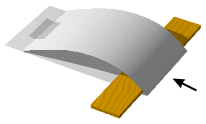As we have seen so far, aircraft design affects how an
airplane performs in the air. The four forces of flight are: lift, gravity (or
weight), thrust, and drag.
A pilot has to control the actions of these four forces on the
aircraft. Take a look at the following figure:

As we see, an airplane flies with four primary forces: lift,
weight, thrust, and drag. Airplanes are different sizes and weights.
The amazing thing is that they all are able to fly. How does lift,
weight, thrust and drag help an airplane to fly? For an airplane to
leave the ground and fly, the lift produced by the wing must be equal
to or greater than the weight of the airplane. When an airplane is
flying straight and level and at a constant speed all four aerodynamic
forces are equal.
Since the time of Wright Brothers (1903), we have made many
improvements in airplanes. In today’s world planes fly faster, farther,
and carry much more weight than the first airplanes. Can you guess how
much a 747 weights? Click here to find out!
When an airplane flies, the
pilot uses a combination of climbs, dives and turns to maneuver the
aircraft. On take-off the pilot throttles the engines up to full power
to produce maximum thrust. Since the thrust is greater than the drag
the airplane accelerates down the runway, gaining speed until he is
going fast enough to fly. The pilot then begins to climb leaving the
runway.
An airplane in flight is the center of a continuous tug of war
between the opposing aerodynamic forces of lift versus gravity and
thrust versus drag. Gravity pulls down on the plane opposing the lift
created by air flowing over the wing (as shown in the figure above).
Thrust is generated by the propeller and opposes drag caused by air
resistance to the frontal area of the airplane. During take off, thrust
must overcome drag and lift must overcome gravity before the airplane
can become airborne. In level flight at constant speed, thrust exactly
equals drag and lift exactly equals the pull of gravity. For landings
thrust must be reduced below the level of drag and lift below the level
of gravity.



